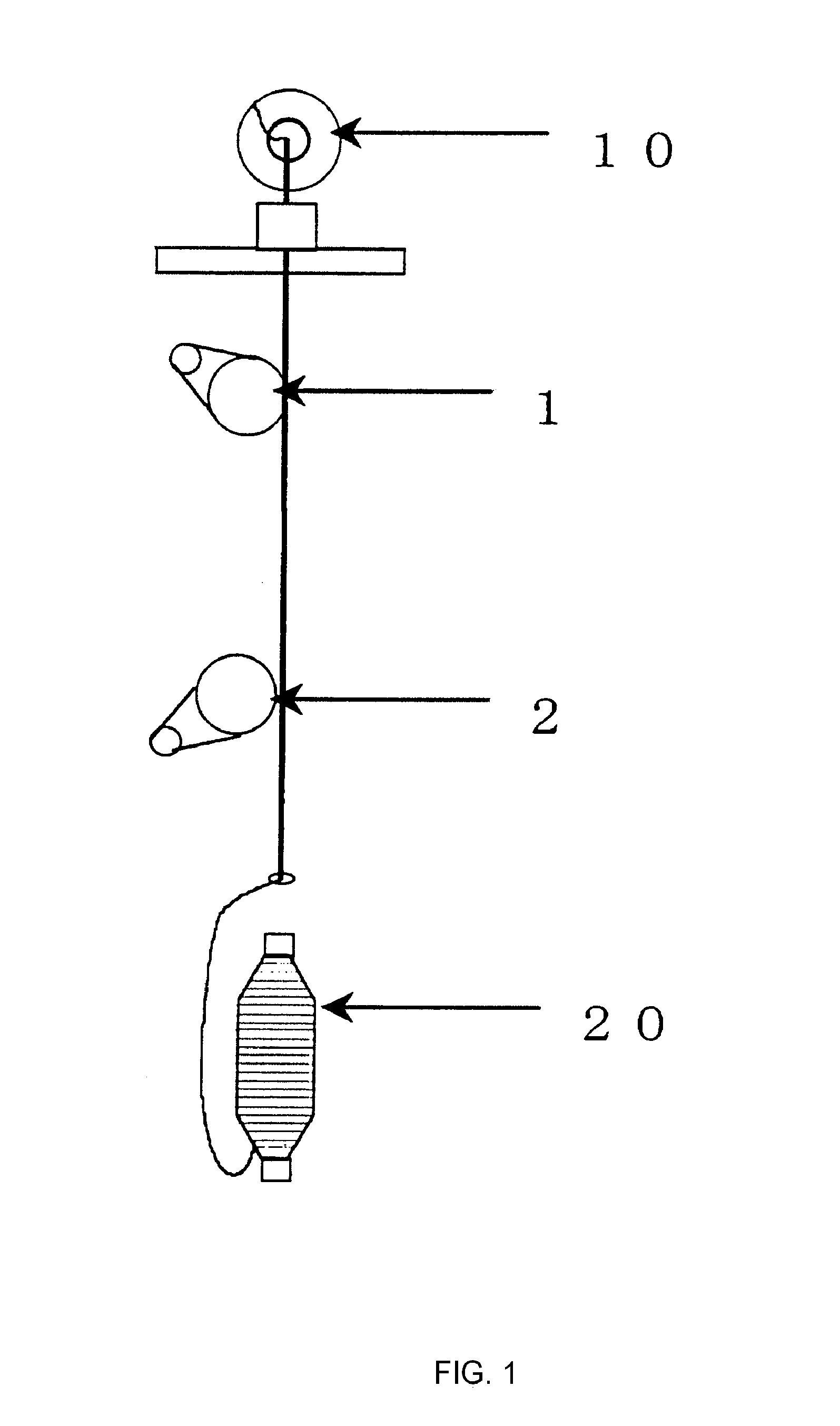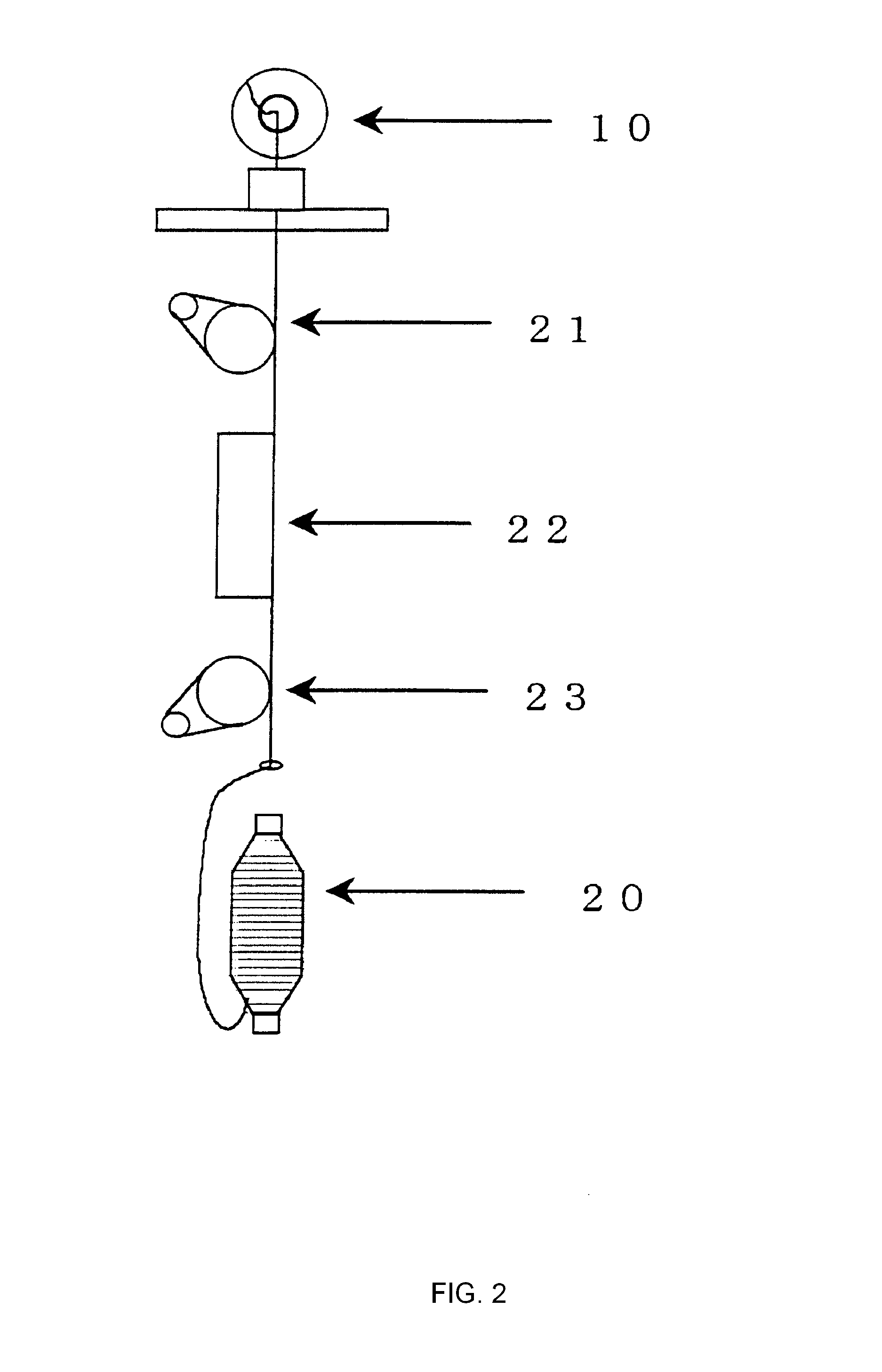Polylactic acid resin, textile products obtained therefrom, and processes for producing textile products
a technology of polylactic acid resin and textile products, which is applied in the direction of weaving, spinning, knotting, etc., can solve the problems of poor process throughput, unsuitable practical applications, and affecting the use of textile products
- Summary
- Abstract
- Description
- Claims
- Application Information
AI Technical Summary
Benefits of technology
Problems solved by technology
Method used
Image
Examples
examples 1-3 to 1-5
, AND COMPARATIVE EXAMPLES 1-6 TO 1-9
[0063]Tables 1-2 and 1-3 show the changes of spinning ability, service life nozzle and incidence of fluffs during drawing when the monomer content in the polymer is changed and the results of the quality of the fiber.
[0064]In Comparative Examples 1-6 to 1-8, the resin was heat-decomposed during spinning due to particularly large content of the monomer in the polymer. Spinning was quite difficult due to large decrease of the viscosity of the polymer during spinning, the service life of the nozzle was only one day, and a large quantity of fluffs was generated in the drawing process. The filament obtained had a poor fiber quality with a tensile strength of less than 3.5 cN / dtex to make the filament to be practically inapplicable.
[0065]The monomer content was also large in Comparative Example 1-9, and the resin was inadequate for practical use since the service life of the nozzle was as short as five days.
[0066]The rate of decrease of viscosity durin...
examples 1-6 to 1-7
, AND COMPARATIVE EXAMPLES 1-10 TO 1-14
[0069]Tables 1-4 and 1-5 show the result of spinning with respect to changes of the proportion of L-isomer, presence / absence of the branched structure, and the molecular weight of the polymer and relative viscosity.
[0070]Although the polymer in Example 1-6 has similar properties to the polymer in Comparative Example 1-10 except the presence or absence of the branched structure, the polymer in Comparative Example 1-10 having the branched structure has somewhat poor spinning ability while generating fluffs during drawing, and the tensile strength of the fiber obtained in the comparative example is lower than 3.5 cN / dtex as compared with that of the fiber without any branches. Accordingly, the fiber in Comparative Example 1-10 was practically inapplicable.
[0071]Crystal orientation is not advanced during spinning and drawing in the fiber in Comparative Example 1-14(Table 1-5) containing less than 95 mol % or less of the L-isomer due to the decrease...
example
[0113]The embodiments of the present invention will be described with reference to examples.
[0114]The processes for measuring and evaluating each property will be described first. Measurements and evaluations other than described below were carried out in accordance with the processes as hitherto described.
[0115]The birefringence of the fiber was measured by a Berek compensator method using α-bromonaphthaline as an immersion solution.
(Thermal Stress)
[0116]A thermal stress measuring instrument TYPE KE-2S made by Kanebo Engineering Co. was used.
(Fatigue after Dyeing)
[0117]A cylindrical knit sample was prepared using the multifilament, and the sample was dyed under an atmospheric pressure using a disperse dye. Fatigue of the sample after dyeing was totally evaluated in three steps of A, B and C:[0118]A: very good (not fatigue at all)[0119]B: good[0120]C: poor (fatigue is so large that the product is not applicable as commercial products)
PUM
 Login to View More
Login to View More Abstract
Description
Claims
Application Information
 Login to View More
Login to View More - R&D
- Intellectual Property
- Life Sciences
- Materials
- Tech Scout
- Unparalleled Data Quality
- Higher Quality Content
- 60% Fewer Hallucinations
Browse by: Latest US Patents, China's latest patents, Technical Efficacy Thesaurus, Application Domain, Technology Topic, Popular Technical Reports.
© 2025 PatSnap. All rights reserved.Legal|Privacy policy|Modern Slavery Act Transparency Statement|Sitemap|About US| Contact US: help@patsnap.com



